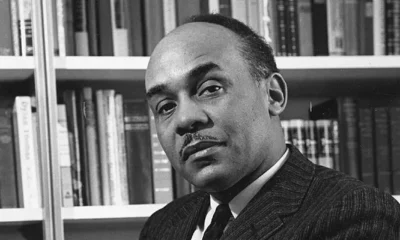Human Interest
Jay Mark Explores the Rich History of Jerome’s Mining Town

Jay Mark, a former antiques and bookstore owner, recently shared insights about Jerome’s rich history during a presentation at the Sedona Public Library’s Si Birch Community Room. Mark, who has contributed to the Arizona Republic and Antiques Register, emphasized the town’s resilience through various adversities.
“Jerome has faced numerous challenges, including fires, floods, and economic downturns, yet it endures,” Mark noted, highlighting the town’s capacity to withstand hardships that would have overwhelmed less resilient communities in Arizona.
Delving into Jerome’s unique geography, Mark explained that its precarious position on a 30-degree slope on Mingus Mountain was pivotal for its development as a mining hub. He recounted how Spanish explorer Antonio de Espejo was the first Anglo to traverse the area in the 1580s seeking valuable minerals.
“De Espejo met the Hopi and followed leads on silver mines west of their territory,” Mark stated. Although he discovered copper deposits near the present-day site of Jerome, he was initially unimpressed by their potential. This early exploration set the stage for further settlement as the region joined the United States post the Mexican-American War in 1848.
As gold was discovered near Prescott in 1863, a surge of prospectors descended on the area. Joseph Walker and his group, seeking fortunes, uncovered valuable lode deposits in what became the Big Bug Mining District, south of Prescott. Their findings further ignited interest in the region.
Mark showcased a historical photograph of Jerome’s bandstand from 1901 or 1902, illustrating the town’s vibrant community life, with decorations that suggest a celebration like Cinco de Mayo. The image, courtesy of Herbert V. Young and the Jerome Historical Society, captures the spirit of the era.
The town’s mining boom began in earnest with a claim filed by Albert Sieber, a German immigrant and Civil War veteran, in 1876. Mark described Sieber’s discovery of a copper mine named “The Burning Queen,” located on Cleopatra Hill. The promise of riches attracted numerous prospectors, leading to a significant influx of people.
Sieber’s harrowing experiences during the Apache Wars revealed his fortitude, as he survived numerous injuries throughout his life, but tragically met his end under a boulder at age 63. Mark recounted the last moments of Sieber, as he attempted to move a massive rock at the Roosevelt Dam site in 1907, highlighting the relentless determination of the man.
William A. Clark, known as one of the “Copper Kings” of Montana, played a significant role in Jerome’s mining legacy. He acquired the United Verde mine, which became the richest privately-owned copper operation globally. Clark’s controversial political career, marked by bribery scandals, prompted broader electoral reforms with the eventual passage of the 17th Amendment.
Sieber’s legacy extends beyond his mining achievements. His modest estate, with a horse and a few possessions, underscored the sacrifices made by many during that time. He was laid to rest in the Globe cemetery, surrounded by rumors of foul play, which were never substantiated.


















